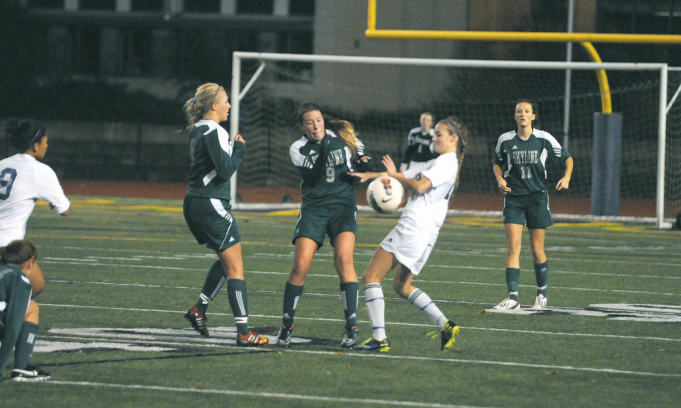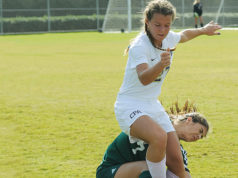For the first time in the history of the Laws of the Game, the referee is being directed to take a certain approach because a player decided to “take a risk.”
Let’s take a look at several specific scenarios that appeared in the 2019-20 edition of the Laws of the Game — one where “risk” was explicitly stated, two where “risk” is implied and one where the implication of risk could be extended.
Handball
In the past, a hand/arm raised above shoulder levels was assumed to automatically draw a handball offense decision under Law 12 if the raised hand/arm made contact with the ball. As of the 2019-20 Law changes, the handball offense has been clarified in several ways, including the possibility of the contact being accidental. In explaining these changes, the International Board (IFAB) inserted the notion that raising the hands/arms above the shoulder level was “taking a risk” — arguments that it was accidental or unavoidable were on shaky grounds because merely having a hand/ arm above shoulder level was risky behavior and the player must accept the offense even so.
Laws 13 and 16
The Board approached two other scenarios in a similar manner, though without specifically basing the issue on “risk”— free kicks from within a team’s own penalty area (Law 13) and goalkicks (Law 16). In each of these cases, the issue arises because the Law changed the definition of when the ball was in play. In both situations, opponents were and still are expected to be outside the penalty area and are not permitted to enter that area until the ball is in play. But now, the distance it takes to put the ball in play has been shortened from exiting the penalty (as much as 18 yards or more) to a matter of mere inches. Add in the fact that free kicks and goalkicks are not automatically ceremonial (meaning that, in most cases, they can be taken quickly at the option of the kicking team) and you have a situation in which one or more opponents might still be, through no fault of their own, inside the minimum distance solely because the kicking team took the quick kick option.
In these two scenarios (free kick inside a team’s own penalty area and a goalkick), if the quick free kick option is used, it is in effect at the kicker’s risk. If the ball is controlled by an opponent who was already inside the minimum distance, the Law allows play to continue. If the kick was badly taken or the kicker’s judgment was in error as to a presumed quick-start advantage and the result is that control of the ball is gained by that opponent inside the penalty area, no offense has been committed — play continues. The only specific prohibition involves an opponent beyond the minimum distance but who enters the area or touches/plays the ball before the ball is in play — the restart must be retaken in such a case and the encroaching opponent is potentially subject to a caution. In effect, the kicker “takes a risk” by kicking the ball with opponents still in the penalty area rather than taking the option of requesting the referee to enforce the minimum distance.
Extending the Notion of Risk
Expanding a new Law change to other scenarios is itself risky. The new IFAB language in Laws 13 (free kick inside a team’s own penalty area) and 16 (goalkicks) could also be applied to free kicks taken outside a team’s own penalty area. Arguably, a kicker taking a free kick in any other part of the field where the usual 10 yards is the only minimum distance requirement could face the same risk if the decision is to kick quickly despite an opponent being within that minimum distance. U.S. referees have long assumed that opponents closer than 10 yards in a quick free kick restart are not committing an offense if the kicker kicks the ball directly to that opponent but does commit an offense (failing to respect the minimum distance) if that opponent gains control by moving to the ball. There is a strong argument that these kinds of free kick scenarios should now be approached by the referee the same way the IFAB has pointed us toward regarding, say, goalkicks. The kicker took a risk and now must live with the consequences.
It is worth thinking about.
Dan Heldman, Tyler, Texas, is a former soccer coordinator for Referee. He is a high level assessor and instructor.
What's Your Call? Leave a Comment:
Note: This article is archival in nature. Rules, interpretations, mechanics, philosophies and other information may or may not be correct for the current year.
This article is the copyright of ©Referee Enterprises, Inc., and may not be republished in whole or in part online, in print or in any capacity without expressed written permission from Referee. The article is made available for educational use by individuals.

















